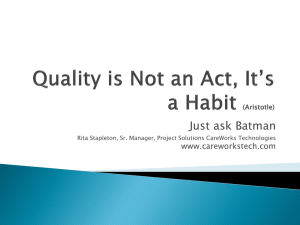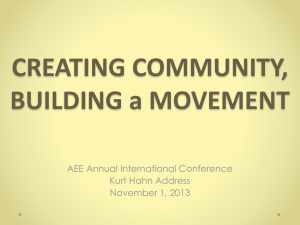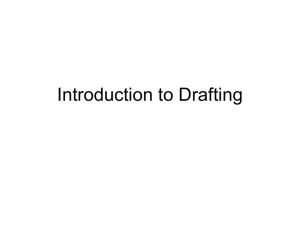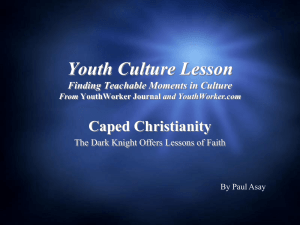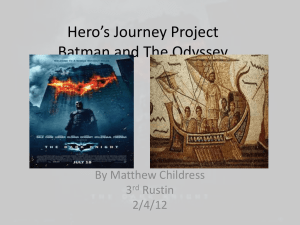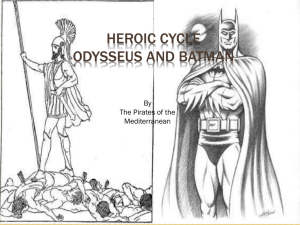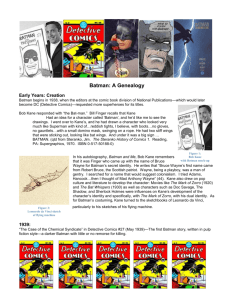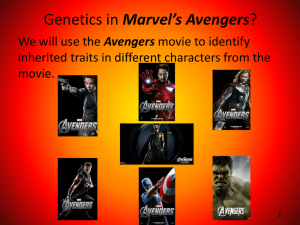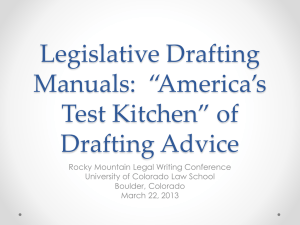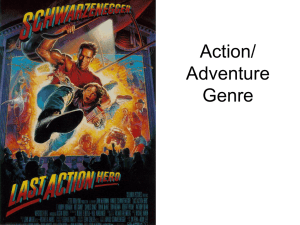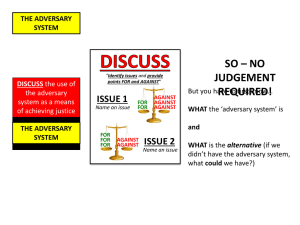AALS2014
advertisement
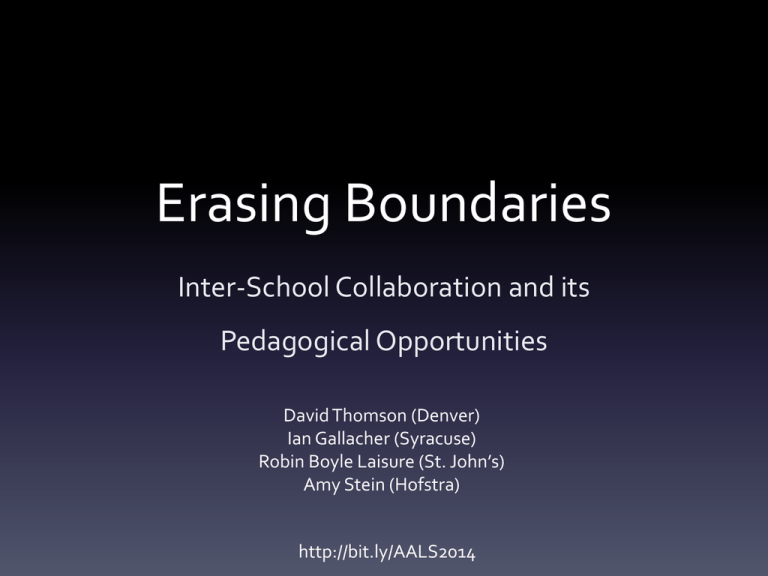
Erasing Boundaries Inter-School Collaboration and its Pedagogical Opportunities David Thomson (Denver) Ian Gallacher (Syracuse) Robin Boyle Laisure (St. John’s) Amy Stein (Hofstra) http://bit.ly/AALS2014 David Thomson University of Denver Amy Stein Hofstra University Ian Gallacher Syracuse University Robin Boyle Laisure St. John’s University Experiential Learning + Internet-based Video Technology = This Presentation What is “Experiential Learning?” Let’s look at a definition of the term What is Internet-based Video Technology? Ian Gallacher Robin Boyle Laisure Benjamin Franklin • “Tell me and I forget. • Teach me and I remember. • Involve me and I learn.” David Kolb & Roger Fry’s 4 Step Model - Circular 1 – Concrete experience 2 - Observation and reflection 3 – Formation of abstract or theoretical concepts 4 – Testing or applying these theories and concepts in new situations. Experiential Learning • Forefront of legal education: • 1992 MacCrate Report • 2007 Carnegie Report • 2007 Best Practices for Legal Education • All stressed the importance of applied legal training in law school. 2011 ABA Resolution - passed • “That the ABA take steps to assure that law schools . . . provide the knowledge, skills, values, habits and traits that make up the successful modern lawyer. • That the ABA urges legal education providers to implement curricular programs intended to develop practice ready lawyers including, but not limited to enhanced capstone and clinical courses . . . .” Responses by law schools • Concentrations • Certified Programs • Centers of Excellence • Clinics • Field Placements • Curriculum-Integrated and Field Practicum • Co-ops • Job titles that include “Experiential” Opening the transactional drafting classroom • Students learn concrete concepts (Kolb) • Apply knowledge in interactive setting (Kolb) • Use creative approaches to problem solving • Removed from comfort zone (no longer their peers) • Minimal opportunities for plagiarism Students can negotiate • Asset Purchase Agreement (Buyer/Seller) • Real Estate Transaction • Employment Agreement (Ex - Professional Sports Team) • Service Agreement (Ex - b/w wedding vendors and celebrities) • Prenuptial Agreements (b/w celebrities) Ex of some creative contracts • Lessor desires to lease his DeLorean Time Machine to the Lessee. • Lessee agrees to travel to the Future in the Time Machine for the sole purpose of retrieving the Cure to treat Lessor’s brain cancer. Time Travel Negotiation Points • Once the mission is accomplished – what is payout? • (20 million shares of google stock) • Representations and Warranties • Covenants • Conditions to Obligations Lessor’s Reps & Warranties • Lessor owns the DeLorean Time Machine and has full rights to the vehicle, free and clear of any liens. • The DeLorean Time Machine is in safe working condition and is free of any known faults or defects, which would affect its safe operation under normal use. • The DeLorean Time Machine is capable of traveling at least one hundred (100) years into the Past and at least eighty (80) years into the Future. The Avengers & Batman, Inc. • This Agreement provides for The Avengers subcontracting Crisis X to Batman, Inc. • Crisis X involves the circumstances surrounding the appearance of the infamous Law-Man and his goal of world domination. (“Crisis X”). • Law-Man’s sudden appearance from Dimension X has spread terror across Earth. His main powers include the ability to mind control any lawyer and make them perform evil deeds, including the ability to write obscenely long, pompous legalese as never seen before. Problem solving . . . – “Super Hero Groups” means any crime fighting group . . . except for The Avengers and Batman, Inc. – Obligation to Prevent Interference. The Avengers shall take Reasonable Steps to prevent Super Hero Groups from Interfering with Batman, Inc.’s ongoing resolution of Crisis X. The what if’s • Failure to Prevent Interference. If The Avengers fail to prevent interference and – it took Reasonable Steps, then Batman, Inc. may stop performance, without receiving any payment. – it did not take Reasonable Steps, then Batman, Inc. may stop performance and receive 1.3 times the restitution conferred onto The Avengers. By opening up the classroom • Students will - • Apply concrete concepts; • Solve legal issues; • Engage collaboratively w/their home team; • Negotiate w/ students they don’t know (another school); & • Draft agreements at arm’s length. Recommended reading Experiential learning: • Michele Mekel, Putting Theory Into Practice: Thoughts from the Trenches on Developing a Doctrinally Integrated Semester-InPractice Program in Health Law and Policy, 9 Ind. Health L. Rev. 503 (21012). • Stephen M. Johnson, Teaching for Tomorrow: Utilizing Technology to Implement the Reports of MacCrate, Carnegie, and Best Practices, 92 Neb. L. Rev. 46 (2013) Con’t • Janet Weinstein, et al. Teaching Teamwork to Law Students, 63 J. Legal Ed. 36 (2013) • Karl S. Okamoto, Teaching Transactional Lawyering, 1 Drexel Law rev. 69 (2009). Contract Drafting: • Tina Stark, DRAFTING CONTRACTS: HOW AND WHY LAWYERS DO WHAT THEY DO (2d forthcoming). Amy Stein “Kickin’ it Old School”-Discovery I• Day One Written Discovery – Divide students into law firms representing P and D – Lecture- Discovery Background and Context – Students draft Interrogatories, Request for Production of Documents & Notices to Admit – Instructor provides feedback on documents – Students redraft documents – Students exchange documents with adversary Discovery I- Written Discovery • Day Two – Lecture- Responding to Discovery Demands – Students draft responses to Interrogatories, Request for Production of Documents & Notices to Admit – Instructor provides feedback on responsive documents – Students redraft documents – Students exchange documents with adversary Discovery I- Written Discovery • Day Three – The high point of the course: • Firms negotiate regarding discovery issues Newfangled Learning- VoiceThread DRAFTING & ARGUING THE SUMMARY JUDGMENT MOTION • Day One – All students represent P – Prior to class, students watch lectures- Theory of the Case & Motion Writing – Students draft Statement of Undisputed Facts and Memorandum in Support of Plaintiff’s Motion – Instructor provides feedback on documents – Students redraft documents – Students exchange documents with assigned adversary DRAFTING & ARGUING THE SUMMARY JUDGMENT MOTION • Day Two – All students represent D – Overnight students watch lecture- Responding to Motions – Students draft Response to Statement of Undisputed Facts and Memorandum in Opposition to Plaintiff’s Motion – Instructor provides feedback on documents – Students redraft documents – Students exchange documents with assigned adversary DRAFTING & ARGUING THE SUMMARY JUDGMENT MOTION • Day Three – The high point of the course: • Students are assigned to argue the SJ motion on behalf of P or D in front of a judge Small Group Discussion How might you use Internet-based Video Technology to extend the Experiential Learning opportunities in a course that you currently teach (or would like to teach)? ~ 5 Minutes ~ Q&A Erasing Boundaries Inter-School Collaboration and its Pedagogical Opportunities http://bit.ly/AALS2014
